TOYOTA GR YARIS 2020 Owners Manual
Manufacturer: TOYOTA, Model Year: 2020, Model line: GR YARIS, Model: TOYOTA GR YARIS 2020Pages: 458, PDF Size: 105.69 MB
Page 291 of 458

289
6
YARIS(GR) Owner's Manual_Europe_M52L09_en
6-4. Do-it-yourself maintenance
Maintenance and care
faces up to avoid scratching the wheel
surface.
1 Remove any dirt or foreign mat-
ter from the wheel contact sur-
face.
If foreign matter is on the wheel contact
surface, the wheel nuts may loosen while the vehicle is in motion, causing the tire to come off.
2 Install the tire and loosely
tighten each wheel nut by hand
by approximately the same
amount.
Turn the wheel nuts until the washers come into contact with the disc wheel.
Washer
Disc wheel
WARNING
■Replacing a tire
●Observe the following precautions.
Failure to do so may result in serious
injury:
Do not touch the disc wheels or the
area around the brakes immediately
after the vehicle has been driven.
After the vehicle has been driven the
disc wheels and the area around the
brakes will be extremely hot. Touch-
ing these areas with hands, feet or
other body parts while changing a tire,
etc., may result in burns.
●Failure to follow these precautions
could cause the wheel nuts to loosen and the tire to fall off, result-ing in death or serious injury.
• Have the wheel nuts tightened with a torque wrench to 103 N•m (10.5
kgf•m, 76 ft•lbf) as soon as possible after changing wheels.
• When installing a tire, only use wheel nuts that have been specifi-cally designed for that wheel.
• If there are any cracks or deforma- tions in the bolt screws, nut threads
or bolt holes of the wheel, have the vehicle inspected by any authorized Toyota retailer or Toyota authorized
repairer, or any reliable repairer.
Installing the tire
Page 292 of 458

290
YARIS(GR) Owner's Manual_Europe_M52L09_en
6-4. Do-it-yourself maintenance
3Lower the vehicle.
4 Firmly tighten each wheel nut
two or three times in the order
shown in the illustration.
Tightening torque: 103 N•m (10.5 kgf•m, 76 ft•lbf)
5 Stow the tire jack and all tools.
■After completing the tire change
The tire pressure warning system must be reset. ( →P.282)
Tire inflation pressure is specified
on the label on the driver’s side
door frame as shown.
Left-hand drive vehicles
Right-hand drive vehicles
WARNING
■After using the tools and jack
Before driving, make sure all the tools and jack are securely in place in their
storage location to reduce the possi- bility of personal injury during a colli-sion or sudden braking.
Tire inflation pressure
Make sure to maintain proper
tire inflation pressure. Tire
inflation pressure should be
checked at least once per
month. However, Toyota rec-
ommends that tire inflation
pressure be checked once
every two weeks. ( →P. 3 5 7 )
Tire-loading information
label
Page 293 of 458
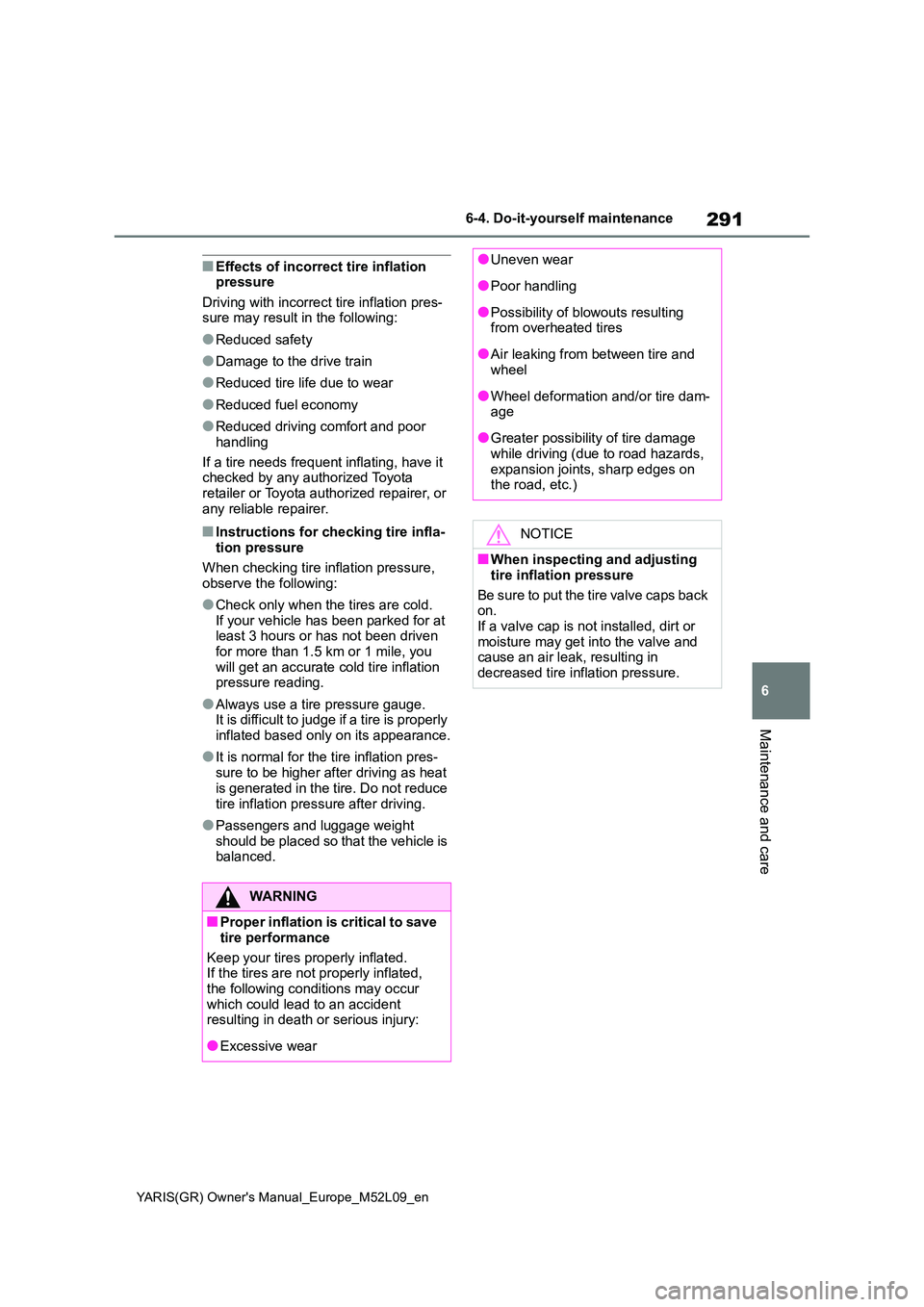
291
6
YARIS(GR) Owner's Manual_Europe_M52L09_en
6-4. Do-it-yourself maintenance
Maintenance and care
■Effects of incorrect tire inflation pressure
Driving with incorrect tire inflation pres- sure may result in the following:
●Reduced safety
●Damage to the drive train
●Reduced tire life due to wear
●Reduced fuel economy
●Reduced driving comfort and poor
handling
If a tire needs frequent inflating, have it checked by any authorized Toyota
retailer or Toyota authorized repairer, or any reliable repairer.
■Instructions for checking tire infla-tion pressure
When checking tire inflation pressure, observe the following:
●Check only when the tires are cold.If your vehicle has been parked for at least 3 hours or has not been driven
for more than 1.5 km or 1 mile, you will get an accurate cold tire inflation pressure reading.
●Always use a tire pressure gauge.It is difficult to judge if a tire is properly
inflated based only on its appearance.
●It is normal for the tire inflation pres-
sure to be higher after driving as heat is generated in the tire. Do not reduce
tire inflation pressure after driving.
●Passengers and luggage weight
should be placed so that the vehicle is balanced.
WARNING
■Proper inflation is critical to save
tire performance
Keep your tires properly inflated. If the tires are not properly inflated,
the following conditions may occur which could lead to an accident resulting in death or serious injury:
●Excessive wear
●Uneven wear
●Poor handling
●Possibility of blowouts resulting from overheated tires
●Air leaking from between tire and wheel
●Wheel deformation and/or tire dam-age
●Greater possibility of tire damage while driving (due to road hazards,
expansion joints, sharp edges on the road, etc.)
NOTICE
■When inspecting and adjusting
tire inflation pressure
Be sure to put the tire valve caps back on.
If a valve cap is not installed, dirt or moisture may get into the valve and cause an air leak, resulting in
decreased tire inflation pressure.
Page 294 of 458
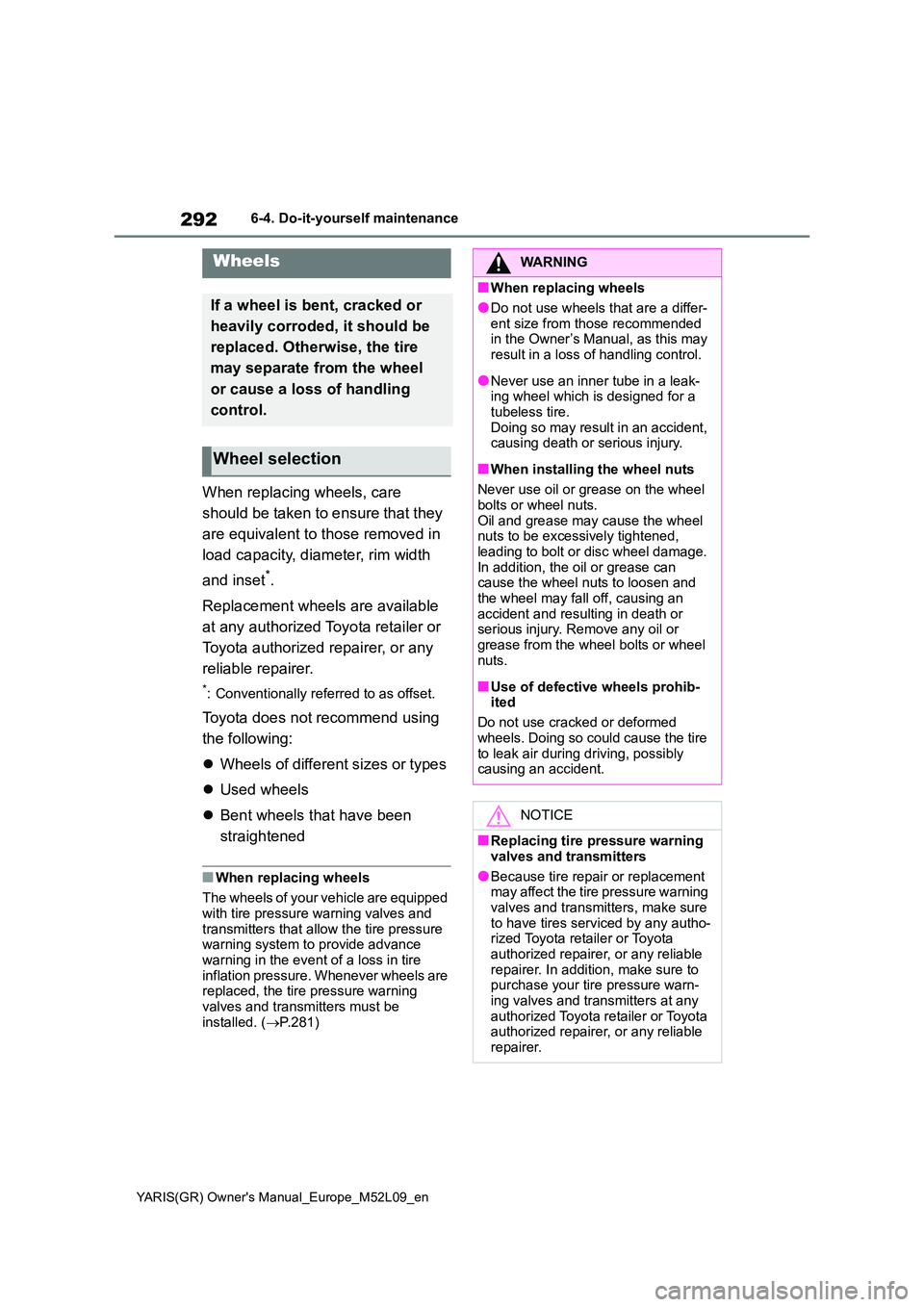
292
YARIS(GR) Owner's Manual_Europe_M52L09_en
6-4. Do-it-yourself maintenance
When replacing wheels, care
should be taken to ensure that they
are equivalent to those removed in
load capacity, diameter, rim width
and inset*.
Replacement wheels are available
at any authorized Toyota retailer or
Toyota authorized repairer, or any
reliable repairer.
*: Conventionally referred to as offset.
Toyota does not recommend using
the following:
�z Wheels of different sizes or types
�z Used wheels
�z Bent wheels that have been
straightened
■When replacing wheels
The wheels of your vehicle are equipped with tire pressure warning valves and
transmitters that allow the tire pressure warning system to provide advance warning in the event of a loss in tire
inflation pressure. Whenever wheels are replaced, the tire pressure warning valves and transmitters must be
installed. ( →P.281)
Wheels
If a wheel is bent, cracked or
heavily corroded, it should be
replaced. Otherwise, the tire
may separate from the wheel
or cause a loss of handling
control.
Wheel selection
WARNING
■When replacing wheels
●Do not use wheels that are a differ-
ent size from those recommended in the Owner’s Manual, as this may result in a loss of handling control.
●Never use an inner tube in a leak-ing wheel which is designed for a
tubeless tire. Doing so may result in an accident, causing death or serious injury.
■When installing the wheel nuts
Never use oil or grease on the wheel
bolts or wheel nuts. Oil and grease may cause the wheel nuts to be excessively tightened,
leading to bolt or disc wheel damage. In addition, the oil or grease can cause the wheel nuts to loosen and
the wheel may fall off, causing an accident and resulting in death or serious injury. Remove any oil or
grease from the wheel bolts or wheel nuts.
■Use of defective wheels prohib-ited
Do not use cracked or deformed
wheels. Doing so could cause the tire to leak air during driving, possibly causing an accident.
NOTICE
■Replacing tire pressure warning
valves and transmitters
●Because tire repair or replacement may affect the tire pressure warning
valves and transmitters, make sure to have tires serviced by any autho-rized Toyota retailer or Toyota
authorized repairer, or any reliable repairer. In addition, make sure to purchase your tire pressure warn-
ing valves and transmitters at any authorized Toyota retailer or Toyota authorized repairer, or any reliable
repairer.
Page 295 of 458
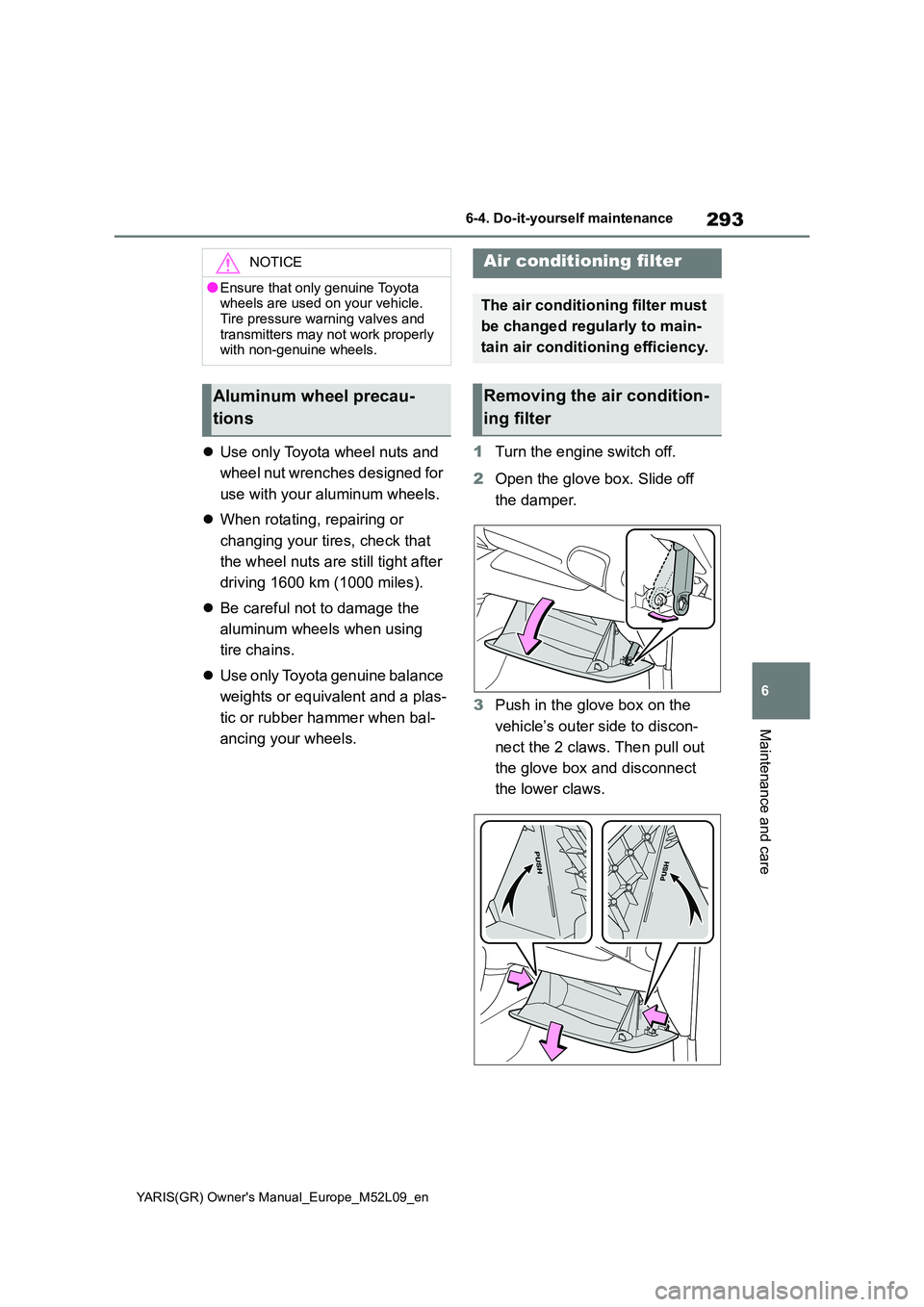
293
6
YARIS(GR) Owner's Manual_Europe_M52L09_en
6-4. Do-it-yourself maintenance
Maintenance and care
�zUse only Toyota wheel nuts and
wheel nut wrenches designed for
use with your aluminum wheels.
�z When rotating, repairing or
changing your tires, check that
the wheel nuts are still tight after
driving 1600 km (1000 miles).
�z Be careful not to damage the
aluminum wheels when using
tire chains.
�z Use only Toyota genuine balance
weights or equivalent and a plas-
tic or rubber hammer when bal-
ancing your wheels.
1 Turn the engine switch off.
2 Open the glove box. Slide off
the damper.
3 Push in the glove box on the
vehicle’s outer side to discon-
nect the 2 claws. Then pull out
the glove box and disconnect
the lower claws.
NOTICE
●Ensure that only genuine Toyota wheels are used on your vehicle.
Tire pressure warning valves and transmitters may not work properly with non-genuine wheels.
Aluminum wheel precau-
tions
Air conditioning filter
The air conditioning filter must
be changed regularly to main-
tain air conditioning efficiency.
Removing the air condition-
ing filter
Page 296 of 458
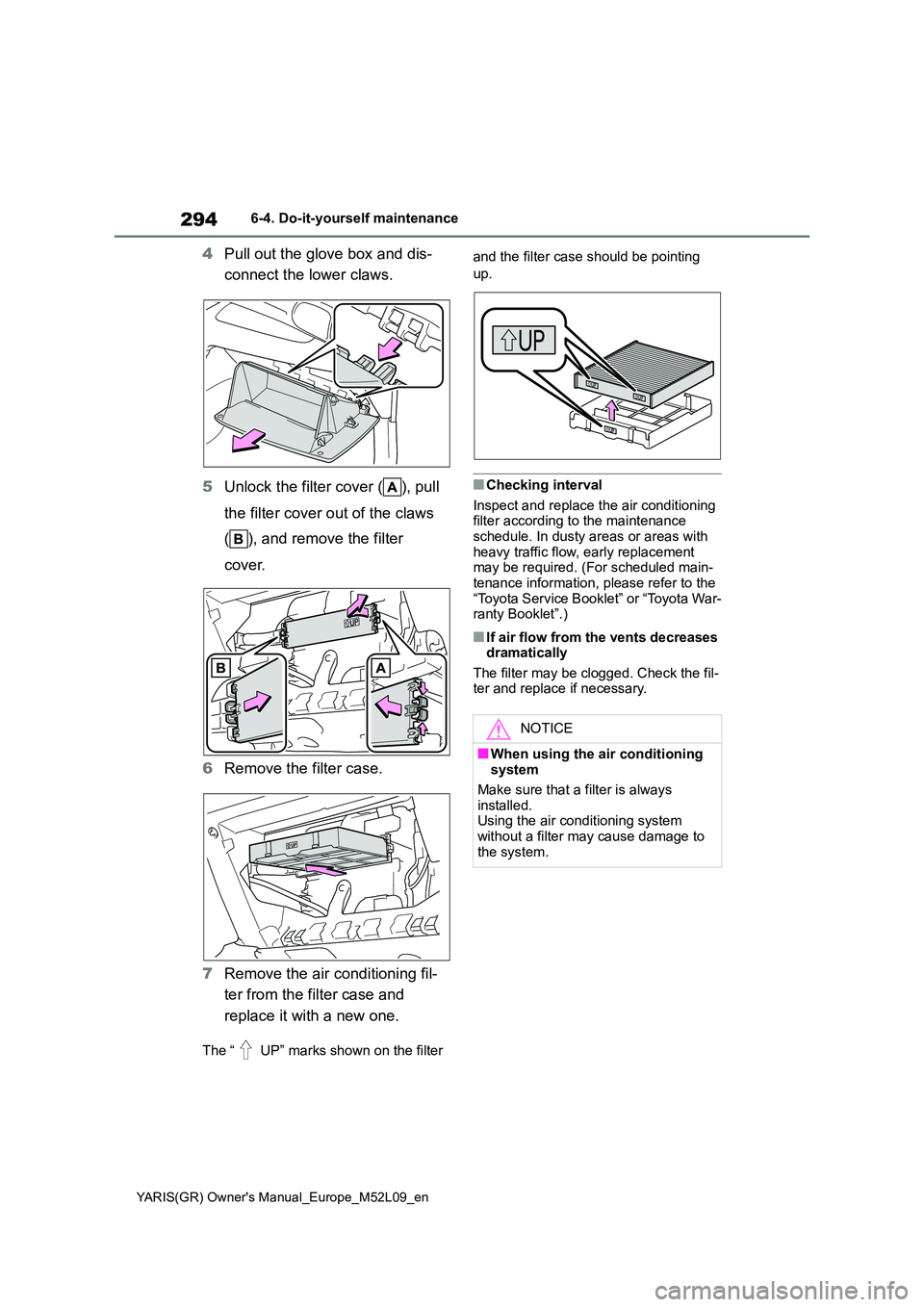
294
YARIS(GR) Owner's Manual_Europe_M52L09_en
6-4. Do-it-yourself maintenance
4Pull out the glove box and dis-
connect the lower claws.
5 Unlock the filter cover ( ), pull
the filter cover out of the claws
( ), and remove the filter
cover.
6 Remove the filter case.
7 Remove the air conditioning fil-
ter from the filter case and
replace it with a new one.
The “ UP” marks shown on the filter
and the filter case should be pointing
up.
■Checking interval
Inspect and replace the air conditioning filter according to the maintenance schedule. In dusty areas or areas with
heavy traffic flow, early replacement may be required. (For scheduled main-tenance information, please refer to the
“Toyota Service Booklet” or “Toyota War- ranty Booklet”.)
■If air flow from the vents decreases dramatically
The filter may be clogged. Check the fil- ter and replace if necessary.
NOTICE
■When using the air conditioning system
Make sure that a filter is always
installed. Using the air conditioning system without a filter may cause damage to
the system.
Page 297 of 458
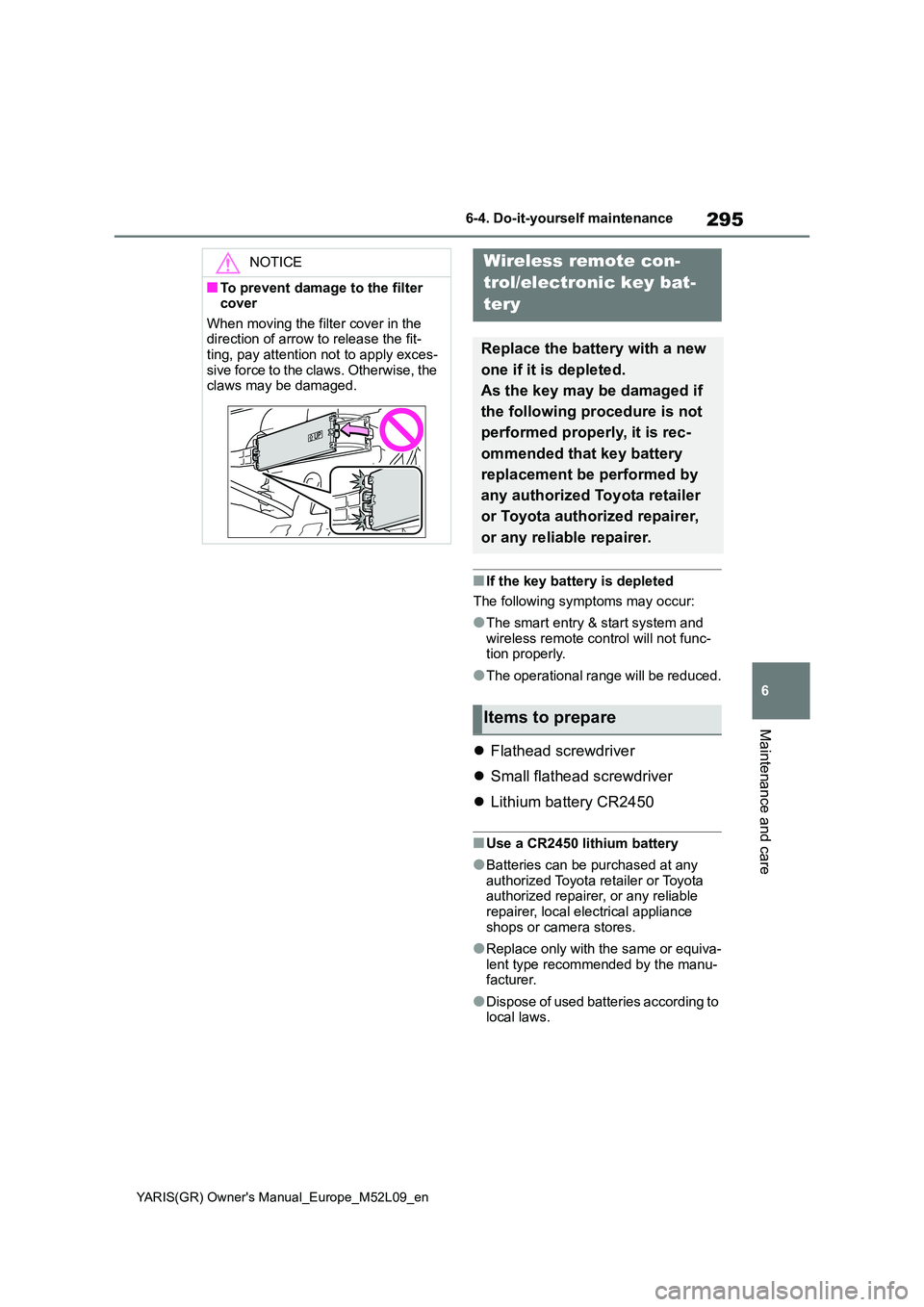
295
6
YARIS(GR) Owner's Manual_Europe_M52L09_en
6-4. Do-it-yourself maintenance
Maintenance and care
■If the key battery is depleted
The following symptoms may occur:
●The smart entry & start system and wireless remote control will not func-tion properly.
●The operational range will be reduced.
�z Flathead screwdriver
�z Small flathead screwdriver
�z Lithium battery CR2450
■Use a CR2450 lithium battery
●Batteries can be purchased at any authorized Toyota retailer or Toyota authorized repairer, or any reliable
repairer, local electrical appliance shops or camera stores.
●Replace only with the same or equiva-lent type recommended by the manu-facturer.
●Dispose of used batteries according to local laws.
NOTICE
■To prevent damage to the filter cover
When moving the filter cover in the direction of arrow to release the fit-ting, pay attention not to apply exces-
sive force to the claws. Otherwise, the claws may be damaged.
Wireless remote con-
trol/electronic key bat-
tery
Replace the battery with a new
one if it is depleted.
As the key may be damaged if
the following procedure is not
performed properly, it is rec-
ommended that key battery
replacement be performed by
any authorized Toyota retailer
or Toyota authorized repairer,
or any reliable repairer.
Items to prepare
Page 298 of 458
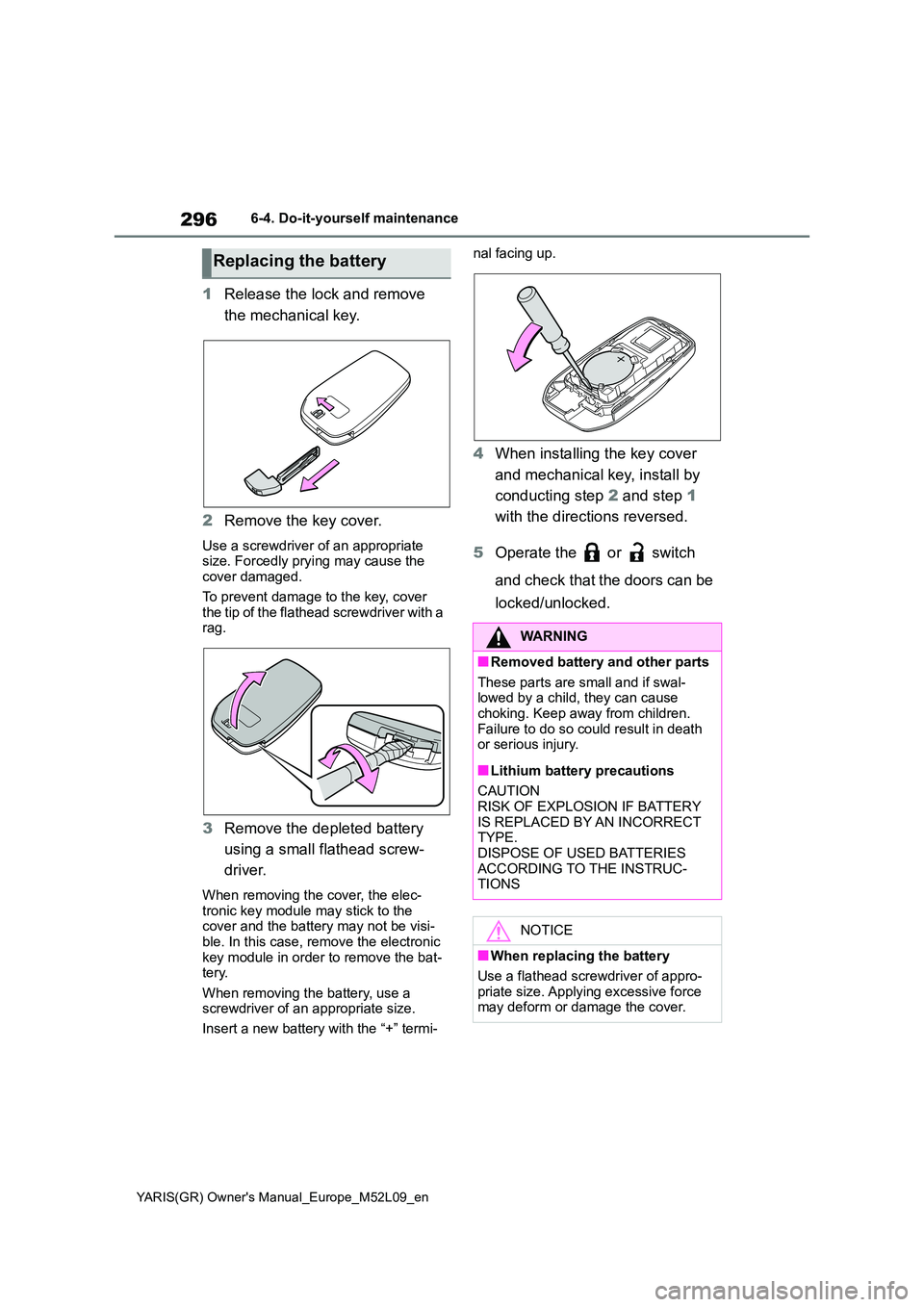
296
YARIS(GR) Owner's Manual_Europe_M52L09_en
6-4. Do-it-yourself maintenance
1Release the lock and remove
the mechanical key.
2 Remove the key cover.
Use a screwdriver of an appropriate size. Forcedly prying may cause the cover damaged.
To prevent damage to the key, cover the tip of the flathead screwdriver with a rag.
3 Remove the depleted battery
using a small flathead screw-
driver.
When removing the cover, the elec- tronic key module may stick to the cover and the battery may not be visi-
ble. In this case, remove the electronic key module in order to remove the bat-tery.
When removing the battery, use a screwdriver of an appropriate size.
Insert a new battery with the “+” termi-
nal facing up.
4 When installing the key cover
and mechanical key, install by
conducting step 2 and step 1
with the directions reversed.
5 Operate the or switch
and check that the doors can be
locked/unlocked.
Replacing the battery
WARNING
■Removed battery and other parts
These parts are small and if swal- lowed by a child, they can cause choking. Keep away from children.
Failure to do so could result in death or serious injury.
■Lithium battery precautions
CAUTION RISK OF EXPLOSION IF BATTERY
IS REPLACED BY AN INCORRECT TYPE.DISPOSE OF USED BATTERIES
ACCORDING TO THE INSTRUC- TIONS
NOTICE
■When replacing the battery
Use a flathead screwdriver of appro-
priate size. Applying excessive force may deform or damage the cover.
Page 299 of 458

297
6
YARIS(GR) Owner's Manual_Europe_M52L09_en
6-4. Do-it-yourself maintenance
Maintenance and care
1Turn the engine switch off.
2 Open the fuse box cover.
Engine compartment
Push the tabs in and lift the lid off.
Luggage compartment
Remove the deck board. (→P.241)
Remove the auxiliary box and then
NOTICE
■For normal operation after replacing the battery
Observe the following precautions to prevent accidents:
●Always work with dry hands.Moisture may cause the battery to rust.
●Do not touch or move any other component inside the remote con-
trol.
●Do not bend either of the battery
terminals.
Checking and replacing
fuses
If any of the electrical compo-
nents do not operate, a fuse
may have blown. If this hap-
pens, check and replace the
fuses as necessary.
Checking and replacing
fuses
Page 300 of 458

298
YARIS(GR) Owner's Manual_Europe_M52L09_en
6-4. Do-it-yourself maintenance
remove the .
Under the driver’s side instru-
ment panel (left-hand drive vehi-
cles)
Remove the lid.
Make sure to push the claw when
removing/installing the lid.
Under the passenger’s side
instrument panel (right-hand
drive vehicles)
Remove the cover, connector (if
equipped) and then remove the lid.
Make sure to push the claw when
removing/installing the lid.
3 Remove the fuse with the pull-
out tool.
Only type A fuse can be
removed using the pullout tool.
4 Check if the fuse is blown.
Replace the blown fuse with a new fuse of an appropriate amperage rating. The amperage rating can be found on the
fuse box lid.